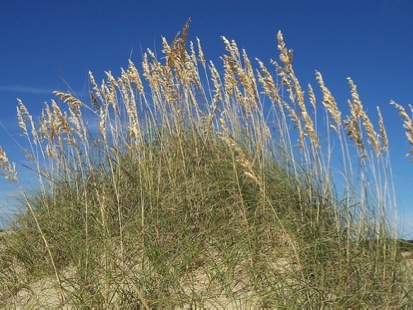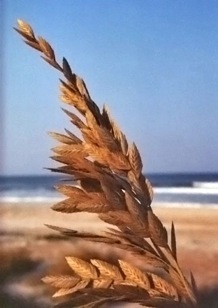Uniola paniculata: Feeling your sea oats
Opinions vary on Sea Oats. Not on flavor. They taste good. The questions are, are they endangered or not, and which genus are they in?
Sea Oats grow in abundance on shores from Texas to North Carolina and are quite edible. They are not on any endangered list but it is illegal to pick them in Florida and Georgia. Why? That is a good debate. They used to be in profusion but like ostrich feathers they were taken for decoration. While their number have dropped they are not really endangered per se.
However, they are a desirable coastal plant –Sea Oats stabilize sand dunes — so they are talked up as endangered. They grow right up to the high tide mark and spread by underground rhizomes. Actually Sea Oats trap wind-blown sands that eventually mound to begin dune formation. A pioneering plant, they rapidly colonize and tolerates sea water and salt spray. They tend to be invasive via the root system but their seeds are often not viable. That should ease your conscience should you take some seeds to plant at home.
More so, any one who has studied beaches know beaches are in constant change and it is doubtful one species will halt the influence of the sea. In that beaches are always moving then perhaps Sea Oats are “endangered” just like beach houses are “endangered” but they are not endangered in the legal sense of the word. However, the official position is that this common plant is “endangered.” Consider eating them in those two states only if your life is “endangered.” One compromise is buy some roots/seed and grow your own. They will flourish in your sunny back yard just as well as they will at the beach. Sea Oats grow to about eight feet high, are highly drought tolerant, and quite showy.
Botanically they are Uniola paniculata (you-NYE-oh-luh pan-nick-yoo-LAY-tuh.) Uniola means one because the plants bracts are united. Paniculata refers to the plant’s flower clusters in panicles. The grain was eaten by several native Indians, as was U. virgata (Limestone Grass) found only in the Caribbean. Virgata (vir-GA-tuh) means wand and the plant, unlike the U. paniculata, has a tight spike at the top. U. palmeri, now called Chasmanthium latifolium, is found inland in many US states. See separate under Wood Oats. ) Sea Oats are sometimes called Chasmanthium paniculata but whether they are in the genus Chasmanthium or Uniola is a botanical teapot tempest.
Uniola paniculata and Chasmanthium latifolium have so many common names I made the decision here to call them by where they grow, Sea Oats because they grow by the sea and Wood Oats because they grow in woods. It makes things a lot easier to remember.
Green Deane’s “Itemized” Plant Profile
IDENTIFICATION: A perennial grass, creeping roots, stout stems, found in dense clumps 3.5 to 8 feet high, leaves long and skinny, tapering, slender tips curling like a ribbon, spikelets flat, oval, straw colored, clustered panicle, eight to 16 inches long, flat seeds enclosed.
TIME OF YEAR: Nearly year round
ENVIRONMENT: Sandy beaches and dune
METHOD OF PREPARATION: Seeds can be cooked as cereal, or ground and made into bread.



